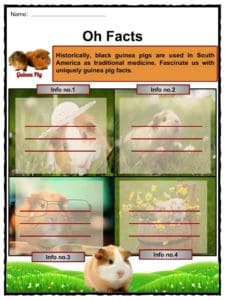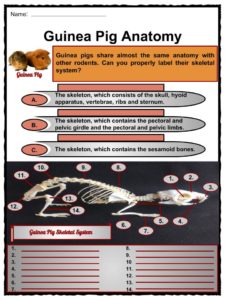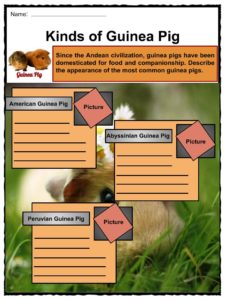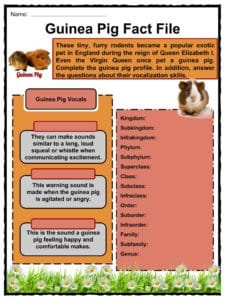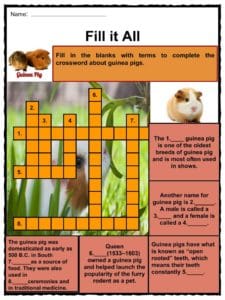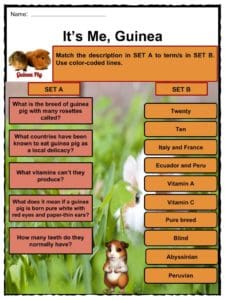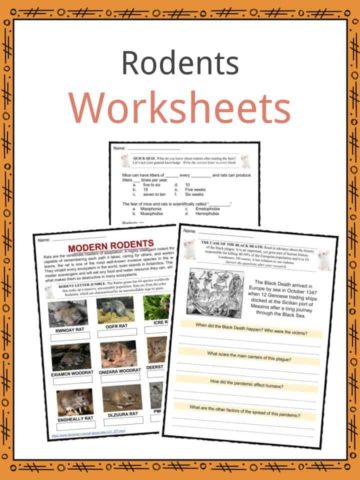Download This Sample
This sample is exclusively for KidsKonnect members!
To download this worksheet, click the button below to signup for free (it only takes a minute) and you'll be brought right back to this page to start the download!
Sign Me Up
Table of Contents
Guinea Pigs are a domesticated species of rodent native to South America. These little rodents are so domesticated today that none exist in the wild.
See the fact file below for more information on the Guinea Pig or alternatively, you can download our 25-page Guinea Pigs worksheet pack to utilize within the classroom or home environment.
Key Facts & Information
Quick Facts
- Scientific Name: Cavia porcellus
- Common Name: Guinea Pig
- Species: Rodent
- Average Life Span: 5 to 8 years
- Average Size: Up to 10 inches long
- Origin: South America
- Activity: Diurnal
- Diet: Herbivores
Guinea Pigs
- The guinea pig’s scientific name is Cavia porcellus.
- It is a species of rodent belonging to the genus Cavia in the family Caviidae. (The rodent family includes rats and hamsters, and beavers and squirrels).
- The guinea pig is also known as a cavy (pronounced “ˈkeɪvi”) or domestic cavy.
- Guinea pigs have stout, compact cylindrical bodies with short limbs.
- They have large heads and eyes, small petal-shaped ears, and a cute triangular mouth containing 20 teeth.
- Their fur varies in color, length, and texture, depending on the species.
- Their feet have hairless soles and short sharp claws with four toes on the front feet and three toes on the back feet.
- Adults guinea pigs range from 10-12 in (25.4 – 30.5 cm) in length and weigh between 1.5 – 2.6 lb (700 – 1179 gr)
- Male guinea pigs are called boars, females are called sows (funnily enough, the same gender names as pigs), but baby guinea pigs are called pups.
- Guinea pigs are diurnal (active during the day) and herbivores (eat only plants).
- They communicate with one another by purring and bubbling, rumbling and chattering, shrieking, and making chirping noises.
- There are many breeds of domesticated guinea pigs, which have been developed since their introduction to North America and Europe.
- The most common variety found in pet stores is the English shorthair (also known as the American), which has a short, smooth coat.
Origin and Behavior
- Guinea pigs originated in South America.
- It is believed that the Inca people began domesticating the wild guinea pig as far back as 5000 BCE
- According to The Guinea Pig Handbook, they were bred for food and as sacrificial animals for the gods.
- Archeologists suggest that the people of ancient Peru worshiped guinea pigs, which often became the subject of their art.
- Guinea pigs can learn complex paths to food and actually remember these learned paths for many months.
- They are not very agile and cannot jump very high.
- Guinea pigs startle easily. When they sense danger, they either freeze in one place for a while or run for cover with quick darting motions.
- When excited, guinea pigs happily perform little hops in the air, similar to rabbit hops and a movement known as “popcorning”.
- Although guinea pigs are good swimmers, they do not really like being wet.
- Guinea pigs self-groom regularly and sometimes participate in social grooming sessions. A milky substance is secreted from their eyes and rubbed into the hair during the grooming process.
- Guinea pigs have a wide angle of vision, about 340°, and see in partial color.
- They also have well-developed senses of hearing, touch, and smell.
Habitat and Diet
- The guinea pigs’ original natural habitat is the mountains of South America.
- They are highly adaptable and survive well in harsh climates.
- Guinea pigs are herbivores meaning they do not eat meat. However, their teeth grow continuously, and chewing tough plants stops the teeth from growing too long.
- In the wild, guinea pigs tend to live in small family groups of three to ten and spend most of their days searching vast areas together, looking for food. They are known to march in single file, led by the largest (dominant) guinea pig, with the youngest in the middle.
- In the wild, guinea pigs eat a variety of foods, including high-fiber grasses, leaves, root vegetables, and fruit.
- Domesticated guinea pigs are fed processed pellets made of alfalfa hay (their favorite) and should be fed fresh vegetables and fruit as well.
- Guinea pigs are unable to produce vitamin C, so pet owners should ensure their pets’ food contains this vitamin or give them supplements to keep them healthy.
Reproduction and Life Cycle
- Male guinea pigs reach sexual maturity at 3-5 weeks of age.
- Females can be fertile and get pregnant as early as four weeks old and breed all year round, having as many as five or six litters in one year.
- Gestation lasts an average of 63–68 days, and litter size is one to six pups.
- Pups are born covered in fur, with teeth, claws, and partial eyesight. They are also immediately mobile.
- Although they can eat solid food immediately, the pups still suckle from their mother for up to six weeks.
- At the age of 4, guinea pigs are considered senior and are prone to diseases.
- Male and female guinea pigs do not differ much in appearance, but males are about 30% larger than females.
Medical Use and Research
- In the Andes, guinea pigs were and still are, used in traditional medicine for treating arthritis and jaundice.
- Since the 1800s, this furry rodent has been used for laboratory experiments in studying toxicology, genetics, pathology, and nutrition.
- They are also used as subjects in biomedical research for tuberculosis, scurvy, diabetes, and even pregnancy complications.
- Guinea pigs were originally domesticated for their meat in the Andes.
- Traditionally the meat was reserved for ceremonial meals and as a delicacy.
- Guinea pigs reproduce extremely quickly and require very little space, so they are a profitable source of food and income.
- Peruvians consume an estimated 65 million guinea pigs each year.
Did You Know?
- Guinea pigs are not native to Guinea, and neither are they biologically related to pigs. They originated in South America and are part of the rodent family.
- Guinea pigs have different names in different languages, including meerschweinchen (little sea pig in German), lapins de barbarie (barbary rabbits in French), and porchitas da India (little pigs from India in Portuguese).
- In English, the term “guinea pig” is often used as a metaphor for being the subject of experimentation.
Guinea Pigs Worksheets
This is a fantastic bundle that includes everything you need to know about Guinea Pigs across 25 in-depth pages. These are ready-to-use Guinea Pigs worksheets that are perfect for teaching students about the Guinea Pigs which are a domesticated species of rodent native to South America. These little rodents are so domesticated today that none exist in the wild.
Complete List Of Included Worksheets
- Guinea Pig Facts
- Oh Facts!
- Guinea Pig Anatomy
- Kinds of Guinea Pig
- Guinea Pig Fact File
- Fill it All
- It’s Me, Guinea
- Fact or Bluff
- Face Off
- Doctor Guinea Pig
- Guinea Pig Lover
Frequently Asked Questions
Are guinea pigs good pets for children?
Guinea pigs are popular pets for children. They are not as fragile as rabbits and are less skittish than hamsters making them wonderful pets for school-age children.
What do pet guinea pigs need?
Pets guinea pigs need a large cage with places to hide, beds, water bottles, bowls, food, and bedding. They should also have toys and chew treats, and supervised time outside their cage.
Do people eat guinea pigs?
Guinea pig is a delicacy in some countries. The meat tastes like a cross between duck and rabbit.
How do guinea pigs communicate?
Guinea pigs are chatty, communicative creatures. They use around 11 different noises to communicate how and generally seem to have plenty to “chatter” about.
What do guinea pigs do all day?
Guinea pigs are active for as much as 20 hours a day. Guinea pigs enjoy running around exploring their environment and also like the stimulation of playing with a variety of toys.
Link/cite this page
If you reference any of the content on this page on your own website, please use the code below to cite this page as the original source.
Link will appear as Guinea Pig Facts & Worksheets: https://kidskonnect.com - KidsKonnect, July 25, 2018
Use With Any Curriculum
These worksheets have been specifically designed for use with any international curriculum. You can use these worksheets as-is, or edit them using Google Slides to make them more specific to your own student ability levels and curriculum standards.

